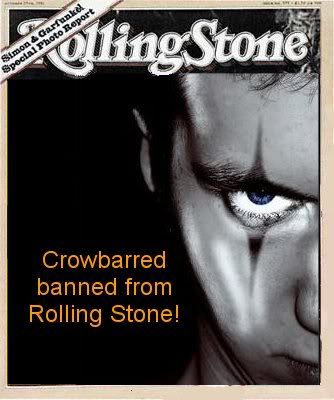Number 618 - Split Enz

.
Number 618
Split Enz
"I See Red"
(1977)
Split Enz
"I See Red"
(1977)
.
Genre:Alt Pop
 Cruise down any old road in West Auckland on a Friday night (Just watch out for the "West Family on Outrageous Fortune you never know where Van & Munta are) and you will here this song pumping out of a house, oh say around 1.00 am'sh and i would care to bet on anybodies house that you will hear this song. This song is as New Zealand is Weetbix, Goodnight Kiwi, Marmite, Buzzy Bee, Telethon 1985 & Jonah Lomu running over someone is. Now Number 671 Split Enz "Message To My Girl" i started Part One about Split Enz and the entry Number 618 will carry on.... (Ps Did ya like me "Glam" look picture just for Split Enz? No? OK, no need to be rude :p)
Cruise down any old road in West Auckland on a Friday night (Just watch out for the "West Family on Outrageous Fortune you never know where Van & Munta are) and you will here this song pumping out of a house, oh say around 1.00 am'sh and i would care to bet on anybodies house that you will hear this song. This song is as New Zealand is Weetbix, Goodnight Kiwi, Marmite, Buzzy Bee, Telethon 1985 & Jonah Lomu running over someone is. Now Number 671 Split Enz "Message To My Girl" i started Part One about Split Enz and the entry Number 618 will carry on.... (Ps Did ya like me "Glam" look picture just for Split Enz? No? OK, no need to be rude :p)Part Two
Australia, 1975 – 1976
 By the end of 1974, their following in New Zealand was strong and dedicated, but the chances of further progress there were obviously limited — the only logical place to go was Australia. In March 1975, the band issued its third single, "No Bother To Me", on the independent White Cloud label, and a few weeks later, Split Enz left for Sydney. The initial response from Australian audiences was mixed, and their music and image was at first simply too "out there" for many Australians.
By the end of 1974, their following in New Zealand was strong and dedicated, but the chances of further progress there were obviously limited — the only logical place to go was Australia. In March 1975, the band issued its third single, "No Bother To Me", on the independent White Cloud label, and a few weeks later, Split Enz left for Sydney. The initial response from Australian audiences was mixed, and their music and image was at first simply too "out there" for many Australians.
At the time, Skyhooks and Hush were probably Australia's most overtly theatrical rock bands, and the influence of the "glam" period could also be seen in acts like Hush, who used costumes and makeup. Even Sherbet and AC/DC had briefly toyed with glam rock stylings, but they had dropped the idea before long. Split Enz were in a league of their own however, and most Australian audiences had seen nothing like them before. They got a frosty reception in Sydney, although they had a slightly warmer welcome in Melbourne, where local bands and other performing groups had more of a history of blending experimental and theatrical elements with rock music. It was around about this time that all members of the band except Phil adopted the use of their middle names.
Mental Notes By the end of 1974, their following in New Zealand was strong and dedicated, but the chances of further progress there were obviously limited — the only logical place to go was Australia. In March 1975, the band issued its third single, "No Bother To Me", on the independent White Cloud label, and a few weeks later, Split Enz left for Sydney. The initial response from Australian audiences was mixed, and their music and image was at first simply too "out there" for many Australians.
By the end of 1974, their following in New Zealand was strong and dedicated, but the chances of further progress there were obviously limited — the only logical place to go was Australia. In March 1975, the band issued its third single, "No Bother To Me", on the independent White Cloud label, and a few weeks later, Split Enz left for Sydney. The initial response from Australian audiences was mixed, and their music and image was at first simply too "out there" for many Australians.At the time, Skyhooks and Hush were probably Australia's most overtly theatrical rock bands, and the influence of the "glam" period could also be seen in acts like Hush, who used costumes and makeup. Even Sherbet and AC/DC had briefly toyed with glam rock stylings, but they had dropped the idea before long. Split Enz were in a league of their own however, and most Australian audiences had seen nothing like them before. They got a frosty reception in Sydney, although they had a slightly warmer welcome in Melbourne, where local bands and other performing groups had more of a history of blending experimental and theatrical elements with rock music. It was around about this time that all members of the band except Phil adopted the use of their middle names.
 The Enz soldiered for nine difficult months although, as at home, they quickly amassed a small fiercely loyal cult following which endures to this day. Their immediate future was assured when they were spotted by Michael Gudinski, who recognised their potential and signed them to a management and publishing deal and a recording contract with his Mushroom Records label. Their reputation as a top-notch live act and their association with Gudinski gained them several very important support slots to local bands like Skyhooks and with major overseas acts in 1974 – 75 including Roxy Music, Lou Reed, Flo & Eddie and Leo Sayer.
The Enz soldiered for nine difficult months although, as at home, they quickly amassed a small fiercely loyal cult following which endures to this day. Their immediate future was assured when they were spotted by Michael Gudinski, who recognised their potential and signed them to a management and publishing deal and a recording contract with his Mushroom Records label. Their reputation as a top-notch live act and their association with Gudinski gained them several very important support slots to local bands like Skyhooks and with major overseas acts in 1974 – 75 including Roxy Music, Lou Reed, Flo & Eddie and Leo Sayer.The association with Mushroom was fortuitous. The company had struggled to survive for its first few years but had recently hit the big time with the record-breaking Living In The Seventies album by Skyhooks and the company was now on their way to being a major player. Mushroom's staff were young, keen, aggressive and willing to take risks — exactly the kind of company Split Enz needed. Although he is often criticised (with some justification) for the treatment of other artists on the Mushroom roster, it is to Gudinski's credit that he stuck by the Enz through thick and thin, and in the long run his faith in them was richly rewarded.
 In two weeks during May/June 1975 they recorded their debut album Mental Notes at Festival's Studio 24 in Sydney. It was produced by David Russell, who was also their tour manager in 1975 – 76. Russell had been the bass player with legendary NZ rockers Ray Columbus (1962 – 65), and went on to play with Ray Brown (1966) and Max Merritt & The Meteors (1971 – 74). The engineer was Festival staffer Richard Batchens, whose credits include The Cleves, Lobby Loyde, Chain, Blackfeather and Sherbet. The Enz were reportedly unhappy with the result at the time, and Tim still regards the album as "deeply flawed" although he acknowledges that time has revealed its unique qualities.
In two weeks during May/June 1975 they recorded their debut album Mental Notes at Festival's Studio 24 in Sydney. It was produced by David Russell, who was also their tour manager in 1975 – 76. Russell had been the bass player with legendary NZ rockers Ray Columbus (1962 – 65), and went on to play with Ray Brown (1966) and Max Merritt & The Meteors (1971 – 74). The engineer was Festival staffer Richard Batchens, whose credits include The Cleves, Lobby Loyde, Chain, Blackfeather and Sherbet. The Enz were reportedly unhappy with the result at the time, and Tim still regards the album as "deeply flawed" although he acknowledges that time has revealed its unique qualities.It was a moderate success on its release in July, selling a respectable 12,000 copies in Australia, reaching #35 on the album chart for one week, and peaking at #7 in New Zealand. It was also a critical breakthrough and along with a handful of other '70s Australian classics, like The Dingoes' debut LP and Madder Lake's Stillpoint, it remains one of the most original and accomplished Australasian debut albums of the period.
Much of the material derived from Tim and Phil's fascination with the work of the renowned English writer and artist Mervyn Peake — notably Spellbound, the epic track "Stranger Than Fiction" (their concert centrepiece) and "Titus", named after the hero of Peake's Gormenghast trilogy.
Enz of the Earth
In September, they released their first Australian single, Maybe, but by this time plans were being made to relocate to the UK. In November 1975, Wally Wilkinson was sacked and Rob Gillies was brought back in on saxophone and trumpet as a permanent member. They returned to New Zealand briefly before embarking on their "Enz Of The Earth" national Australian tour, which wound up in February 1976. In March, Explosion issued the band's second Mushroom single, Late Last Night, accompanied by a promotional video (directed by Crombie) which gave them their first major Australian TV exposure.
End Of Part Two
For Sherbet see Number 731
For Lou Reed see Number 918 & 953
For Leo Sayer see Number 906
Rolling Stone Top 500 Songs ranked this song at Number (As we said before in Number 671..) and the Album ranked at Number (....NO!!)
This song has a crowbarred rating of 71.6 out of 108
Tags:Split Enz, 1977, Alt Pop, Skyhooks, Hush, Sherbet, AC/DC, Roxy Music, Lou Reed, Flow & Eddie, Leo Sayer, Ray Columbus, Ray Brown, Max Merritt, The Cleves, Lobby Loyde, Chain, Blackfeather, The Dingoes, Outrageous Fortune, West Family, Jonah Lomu, Music, Weetbix, YouTube, Music Video, Rolling Stone Magazine, Crowbarred, New Zealand, Crowbarred Unleashed, The Definitive 1000 Songs Of All Time, Mellow Mix Volume 1

By The Year 1955 to 2005:
1955, 1956, 1957, 1958, 1959, 1960, 1961, 1962, 1963, 1964, 1965, 1966, 1967, 1968, 1969, 1970, 1971, 1972, 1973, 1974, 1975, 1976, 1977, 1978, 1979, 1980, 1981, 1982, 1983, 1984, 1985, 1986, 1987, 1988, 1989, 1990, 1991, 1992, 1993, 1994, 1995, 1996, 1997, 1998, 1999, 2000, 2001, 2002, 2003, 2004, 2005
Labels: Split Enz Part 2

















0 Comments:
Post a Comment
<< Home